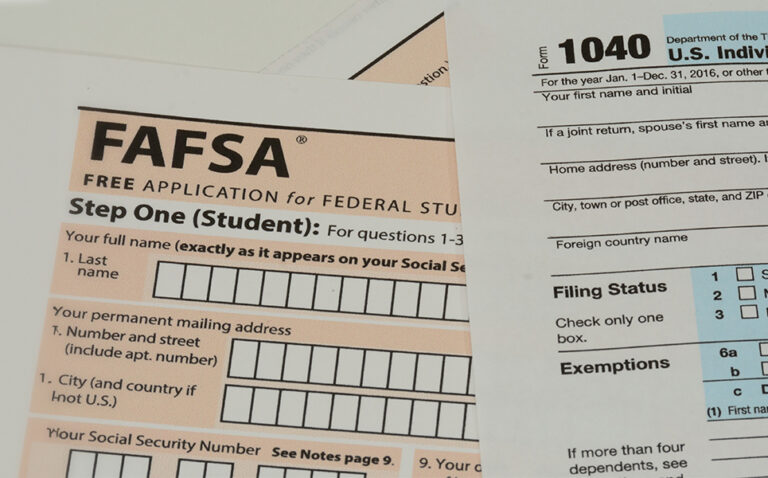Why is the FAFSA the first step in the financial aid process?
Please rotate your device for the best experience.
Transcript
Figuring out the FAFSA
Interactive Video
[A young woman sitting in front of her laptop with her hand on her chin, looking confused and uncertain.]
[Picture of a woman thinking, holding a laptop, with a thought bubble that contains a continuing education icon.]
[On screen text]:Thinking about continuing your education?
Narrator: Thinking about continuing your education? Awesome!
There’s a lot of financial help out there, like grants, scholarships, loans, and work-study programs. If you had to apply for each type individually, it would be a full-time job! [The woman’s thought bubble changes to contain a grant icon, then a scholarship icon, then a student loan icon, then a work study icon.]
[On screen text]: FAFSA
[A hand holding a bag of money with the text “federal and state funded educational aid” above it.]
Luckily, the FAFSA is a one-stop shop to qualify your need for all types of federal- and state-funded educational aid. Wait! What was that acronym again?!?
[On screen Text]:
Free
Application
Federal
Student
Aid
[An article titled, “What is the FAFSA form?]
FAFSA stands for Free Application for Federal Student Aid. It’s a free online form that kickstarts the process for getting money for your education.
[The FAFSA application on a smartphone.]
[On screen text]:
Student Aid Report
- grants
- scholarships
- loans
- work-study
Applications are reviewed by the U.S. Department of Education. Roughly a week after you submit the FAFSA, you’ll receive a Student Aid Report, commonly called the SAR, with information about grants, scholarships, loans, and work-study programs that you’re eligible for.
Any school or training program that offers financial aid will require you to fill out the FAFSA first. And you have to fill it out every year you are in school seeking funds. It’s worth the time to see what you qualify for!
[FAFSA online portal]
[Online text]: October 1st
The FAFSA is available starting October 1st for applications that will apply to the following academic year, which is typically the next Fall semester. You want to apply as early as possible to have the greatest chance at available funds.
[On screen text]:
Your Info
- federal tax forms
- W2s
- savings amounts
- Social Security or Alien registration
Parent/Guardian Info
- highest level education completed
- income
- federal tax forms
- Social Security #
School Info
- FAFSA codes
To prepare, you’ll need to collect some documents and information: your previous year’s federal tax forms, W2s, and savings amounts, your Social Security number or Alien Registration Number (if you are not a U.S. citizen), the highest level of education your parents or guardians completed, income, tax forms, and Social Security numbers for parents or guardians (if you’re a dependent), and FAFSA codes for any schools you want your FAFSA results sent to.
[The FAFSA website login page on a tablet.
[On screen text]: https://studentaid.gov. 30-60 minutes.]
When you’re ready, go to the FAFSA website: studentaid.gov. You can do everything online to complete the FAFSA. The site walks you through each step. It should take between 30-60 minutes to finish.
[A young woman sitting in front of her laptop with her hand on her chin, looking confused and uncertain.]
You should fill out the FAFSA even if you don't think you'll qualify for any aid. At the very least, you’ll qualify for federal loans. And the FAFSA doesn’t obligate you to anything - it just tells you what you’re eligible for.
Within a week after submitting your FAFSA form, you should expect to receive your Student Aid Report or SAR. It will include your Expected Family Contribution or EFC, which determines your eligibility for a Federal Pell Grant.
[A Student Aid Report icon display with three lines, each line connecting to separate school QR code icons. Three school icons display, each with an EFC coin icon sliding out from behind it. A magnifying glass icon displays over each EFC coin.]
Any FAFSA school codes you entered will receive your SAR directly. Schools then use the EFC calculation to assess your eligibility for other financial aid.
[Woman working at a desk, typing on a computer and writing in a notebook.]
[On screen text]: Most schools don’t automatically create financial aid offers for every SAR they receive. Follow up with the financial aid office at the school you plan to attend.
Note that most schools don’t automatically create financial aid offers for every SAR they receive. Follow up with the financial aid office at the school you plan to attend to determine if there are additional requirements or processes for applying for aid.
